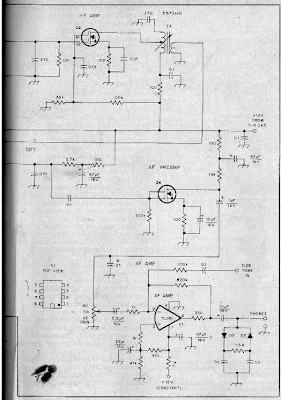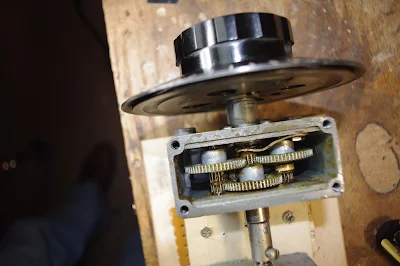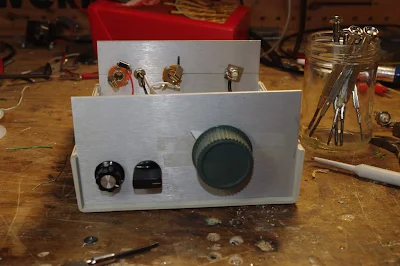Serving the worldwide community of radio-electronic homebrewers. Providing blog support to the SolderSmoke podcast: http://soldersmoke.com
Podcasting since 2005! Listen to Latest SolderSmoke
Friday, October 31, 2025
Dale Parfitt, W4OP, Inducted into the QRP Hall of Fame
Saturday, December 3, 2022
SolderSmoke Podcast #242 Mars, New Hams, Direct Conversion, SDR Console, Proficio, PSSST, 8 meters, A BIG MAILBAG
SolderSmoke Podcast #242 is available
Audio podcast: http://soldersmoke.com/soldersmoke242.mp3
Video: (362) SolderSmoke Podcast #242 December 3, 2022 - YouTube
Travelogue:
Mars at opposition. Not as good as 2020 (see charts below)
SSSS Prep
Hearing aids and high frequency loss.
AirPods as hearing aids.
Out in the Shenandoah with a Baofeng.
Success among TJ High School students.
Satellite in space?
PARTSCANDY
Bill's Bench:
Direct Conversion Receiver: IT IS ALIVE! EVEN IN LTSPICE
PTO works very well.
Diode ring -- really needs a diplexer, Radio Marti.
AF amplifier simplicity.
But WHY can't you listen to DSB on a DC receiver? Now I know.
How does a diode detector work? Is the envelope real? Is it square law?
The benefits of writing... 1967 and 1966 articles on PTOs and 2Qs.
Shameless Commerce Division:
-- MOSTLY DIY RF! NEWS FROM PORTLAND! Get your free Michigan Mighty Mite.
-- YouTube Goal Reached. Thanks! Keep watching. Subscribe!
-- Keep buying from Bezos using the link on the right-hand column of the blog page.
-- Become a Patreon sponsor! Left hand column of blog page.
-- I have ads on the blog page, but I have configured to avoid troublesome ads -- dating sites, etc.
Pete's Bench
-- Stepper motor, LCD and Arduino for my little DC RX?
-- SDR Console
-- PSSST, BOMS, Schematics and spoon feeding...
-- Proficio SDR by Multus
-- 8 meters?
Mailbag
-- Alan Yates VK2ZAY now also W7ZAY PTOs, trivial motors, a broken ankle...
-- Dhaka Jack AI4SV formerly of Cyprus, Madagascar and Northern Virginia. has moved to France!
-- John WB5OAU/K5MO An old friend. FMLA as "Glowbugs Noir"
-- Dale Parfitt W4OP on the Homebrew 2Q from 1967
-- Nick M0NTV Glue Sticks, PTOs, DC receivers and AM breakthrough testing.
-- Todd K7TFC suggests “cool” names for DC RX PT Cruiser? PT109? PT73?
-- Levi replacing Selenium diodes in a Globe VFO. I am not alone!
-- Juanjo EC5ACA wants to build DC RX . FB.
-- Dave designed a discrete LM386. Picked up by Jenny at HackaDay. Can you build this?
-- George Zaff. HamRadio Workbench Spiritual Brother of SolderSmoke.
-- Alain F4IET -- Still building DC receiver. FB. Sorry I got the call wrong.
-- Drew N7DA Building Pixies with 3D forms.
-- Toni G6XMO in Sheffield getting a 3D printer business going: https://www.whizz3dparts.co.
-- Chuck KE5HPW restoring an old SW-54. Pete is skeptical.
-- Lex and Jesse like Colin's placement of WYKSYCDS sticker on his Homebrew rig.
-- Jim KI4THZ joined the Vienna Wireless Society -- FB on the faculty at GMU
-- Tony G4WIF suggested mechanical counter for DC RX PTO freq readout. I have some in the junk box.
-- Our old friend Jonathan-san in W0XO now a Patreon sponsor. Origato!
-- Thomas K4SWL sent him video of Tiny SA watching Vatican Radio sign off for the day.
-- Farhan and Chuck Penson liked blog post about Heathkit Digital Rig SS-8000 1978!
-- Ed KC8SBV working on DC receivers -- I recently used the Peppermint Bark box he sent.
-- Old friend Bob KD4EBM on the linearization of the R-390s. Hard to homebrew one of those!
-- George from VWS trying to figure out how (if?) Marconi got his coherer to work DX...
-- Steve EI5DD sends Connaught Radio news: https://www.docdroid.net/
Won’t have another Podcast until the new year so Happy Holidays to all! Merry Christmas, Happy New Year!
Friday, November 18, 2022
The 2Q -- A Homebrew Solid-State Drake 2-B from 1967
This is really an amazing project. Way back in 1967 (that's 55 years ago) John Aggers W5ETT of Ponca City, Oklahoma decided to homebrew a solid state version of our beloved Drake 2-B receiver. Triple conversion. No crystal filters. Twenty two discrete transistors and no ICs. Tuned circuits at 50 kHz to provide most of the selectivity. And he did it. Just look at the picture above. It even LOOKS like a Drake 2-B.
I sent this to our friend Dale Parfitt, W4OP who more recently built a receiver like this. He too was amazed by this project.
The article by John Aggers is very clear and provides a lot of good information on how he designed and built this receiver using the technology of 1967 and junk box parts. I was struck by the lack of diode ring mixers. And I was somewhat taken aback by his use of plug-in socketed transistors. The AF amplifier is our still-familiar transformer-less push-pull complementary pair design. John did a wonderful job on the mechanical tuning and slide rule mechanism.
Three cheers for John Aggers W5ETT. This article is a reminder of the great benefit to the hobby of writing up a project and putting out there in the world. Here we are, more than half a century later, reading John's article and learning from it. FB OM.
Page 8
Friday, October 28, 2022
SolderSmoke Podcast #241 Mars, Direct Conversion, PTOs and Glue Sticks, Anniversary of the BITX20, Multus Proficio SDR, Boatanchor Station, MAILBAG
SolderSmoke Podcast #241 is available
Audio (podcast): http://soldersmoke.com/soldersmoke241.mp3
Video (YouTube): (215) SolderSmoke Podcast #241 October 28, 2022 - YouTube
Introduction:
Back on Mars. Opposition
approaching. I have a Mars filter. And (like T.O.M.) a Mars
globe.
N2CQR DXCC done
SolderSmoke in the WayBack
Machine
Sticker news
PARTS CANDY -- Don't Scrimp with a Crimp!
Bill's Bench
School DC RX projects -- in
Hyderabad and Northern Virginia.
Direct Conversion Receivers --
Keeping it Simple, Learning a Lot. A step beyond the Michigan Mighty Mite.
Do we really need 100db? Do we really need to shield VFOs? Farhan's
super-simple and stable Colpitts PTO. Audio amps, 1000-8 transformers and
rolling your own LM386
PTOs and Glue Stick PTOs.
Paul Clark WA1MAC. Brass vs. Steel bolts. #20 thread vs. #28
thread. Backlash Blues. The best Glue Sticks.
2 meters and the VWS.
Bill has a Baofeng.
SHAMELESS COMMERCE:
MOSTLY DIY RF
Pete's Bench
20th Anniversary of the
BITX20 Pete's early BITX rigs.
Computer Woes
The Multus Proficio SDR rig
Simple SSB in China
BA7LNN
Things of beauty: Tempo
One, NCX-3 and a SBE-33
MAILBAG
-- NS7V is listening.
-- Graham G3MFJ
sent SPRAT on a stick.
-- Nick
M0NTV FB Glue Stick and 17 Shelf videos.
-- Dino KL0S
HP8640 Junior
-- Mark AA7TA Read the SolderSmoke Book
-- Steve EI5DD Connaught
(Ireland) Regional News
-- Dave
K8WPE Planting the seeds of ham radio
interest
-- Peter VK3YE
Ruler idea on PTO frequency readout
-- Michael AG5VG Glue
Stick PTO
-- Tobias A polymath with UK and Italy
connections. And cool tattoos.
-- Alain
F4EIT French DC receiver
-- Michael
S. was in USMC, working on PCM/TDM gear
-- Alan Yates
writes up Amazon transformer problem
-- Todd VE7BPO, Dale W4OP, Wes W7ZOI
-- Farhan VU2ESE
sent me an sBITX
-- Todd K7TFC The Revenge of Analog
-- Jim Olds Building QRP HB gear
Wednesday, February 9, 2022
Video of SolderSmoke Podcast #235
One contact on uBITX. More SW listening.
Repaired my Chrome Book in Santo Domingo!
Christmas Present for All: James Web Space Telescope launch
Monday, February 7, 2022
SolderSmoke Podcast #235 NE-602, Azores Rig, Spur Problems, SSB Rigs, Peashooter, HB Filters, MAILBAG
SolderSmoke Podcast #235 is available for download:
One contact on uBITX. More SW listening.
Repaired my Chrome Book in Santo Domingo!
Christmas Present for All: James Web Space Telescope launch
Wednesday, February 2, 2022
The NCDXF/IARU Beacons (very useful website)
Tuesday, November 30, 2021
Putting a Barebones Superhet on 17 Meters with an NE602 Converter (Video)
Wednesday, March 11, 2020
QSO Today Interview with Dale Parfitt W4OP
Eric Guth 4Z1UG interviewed Homebrew Hero Dale Parfitt W4OP on the QSO Today podcast. The interview is really great. Listen here:
https://www.qsotoday.com/podcasts/W4OP
Wow, libration fading. Who knew?
Dale has appeared in many SolderSmoke bolg posts and podcasts. He is definitely in the Homebrew Hero category.
Check out some of those blog posts here:
https://soldersmoke.blogspot.com/search?q=Parfitt
and here:
https://soldersmoke.blogspot.com/search/label/Parfitt--%20Dale
Thanks to Eric and Dale.
Saturday, June 22, 2019
SolderSmoke Podcast #212 HDR, Boatanchors, SDR, Antuinos, Spurs, QSX, Mailbag
 |
| Dale Parfitt W4OP's SBE-33 with modern digi freq counter |
http://soldersmoke.com/soldersmoke212.mp3
22 June 2019
CONGRATULATIONS TO PETE: Licensed 60 years today
 |
| Pete Juliano during Field Day, 1959 |
Hans's QSX SDR Rig at Dayton-Xenia and FDIM
W8SX FDIM interviews
Pete's SDR Projects -- Update
The Peregrino SSB transceiver in the summer SPRAT
Why no rare earth cell phone speakers in ham projects?
My HDR "waterfall" project
Farhan's Antuino
Cubesat origins
RF Lab in an box
SWR, PWR, SNA
Superhet receiver with ADE-1 at front, and log IC at the output
Adapters (SMA to BNC) help
DON'T BLOW UP THE INPUT RESISTORS (LIKE I DID!)
My dirty DIGITIA -- Denial, then acceptance
FFT
Useful programs: SPURTUNE and ELSIE
A better bandpass filter for the DIGITIA
The importance of a good test set up with Antuino
Manassas Hamfest: WA1UQO, W4WIN, AI4OT
MAILBAG:
KG7SSB
WA3EIB
VK4PG
W3BBO
Jeff Tucker -- Who owns Drake 2-B #4215?
KN4BXI
KC5RT
K3ASW
Wednesday, October 19, 2016
The Last Hallicrafters Transceiver...REBORN! TWICE!
Pete Juliano and his colleague Giovanni Manzoni led me this morning to the happy land of Hallicrafters hybrid nostalgia.
It all started with Pete's latest blog post:
http://n6qw.blogspot.com/2016/10/more-junk-box-rigs.html
I admit that I had never even heard of the Hallicrafters FPM rigs. Pete's (uh, I mean Giovanni's) video show's Pete's junk-box rebuild of the old rig. Very nice. Note the presence of the Si5351...
I needed more background info, so I turned to YouTube. This led me to more old friends: Dale Parfitt W4OP has a really nice video of his rebuild of the Halli FPM rig (see above). From his video we learn why Dr. Juliano prescribed a dose of Si5351 for the patient: Dale tells us that VFO instability was a major problem with this rig. Dale fixed his with the addition of an X-Lock board from yet another friend of SolderSmoke: Ron G4GXO of Cumbria Designs.
Dale really out-did himself by building an add-on accessory box for the FPM. Very nice. I especially liked the addition of the W3NQN passive audio filter for CW. I always have misgivings about adding audio filters to Direct Conversion receivers -- this will reduce QRM, but you are still listening to both sides of zero beat. But when you add a sharp CW audio filter to an SSB superhet you will end up with true "single signal reception." FB Dale.
Saturday, August 6, 2016
SolderSmoke Podcast #189: Juliano Blue, FET Amp, Si5351 QSK, Bill LC VFO, QSOs
SolderSmoke Podcast #189 is available:
http://soldersmoke.com/soldersmoke189.mp3
Billy in Europe. Bill in Virtual Reality.
Great News: Little Gonzalo is "all clear." Thanks for the help.
BENCH REPORTS:
Pete paints the rigs blue.
Pete's FET amplifier project with FET switching and key pad
Using an Si5351 for CW offset and QSK.
Bill working on VFO for a rig built around HRO dial and gear box.
HRO gears seem a bit loose. What should I do?
The search for an Imperial Whitworth.
For variable caps, brass is better, but two bearings beats brass.
QSO REPORTS
Pete having fun with homebrew rigs.
Bill works K3MRK, WA3O, W4OP, W1VLF and N6ORS
MAILBAG:
Dallas CBLA
Conventional Current Flow Controversy
"I regret ever listening to your podcast!"
LCR recommendations
Saturday, July 16, 2016
Preserving Vanguard 1
Ira Flatow of "Science Friday" was recently talking about how best to preserve important bits of the history of mankind's exploration of space. Our old friend Vanguard 1 was mentioned several times. It is now the oldest satellite still in space.
You can listen to the Science Friday show here:
http://www.sciencefriday.com/segments/protecting-the-historic-human-record-in-space/
They also have a transcript of the show on the same page.
SolderSmoke fans will remember the Vanguard adventures of Mike Rainey AA1TJ:
http://soldersmoke.blogspot.com/search?q=Vanguard
This seems to be the month for Vanguard: just a couple of weeks ago, on 40 meters I spoke to Dale Parfitt W4OP. Dale was one of the first people to pick up Mike Rainey's Vanguard replica signals (see link above).
AND...
The Vanguard reproduction project came up during Eric Guth 4Z1UG's "QSO Today" interview with Graham Firth G3MFJ of the G-QRP Club:
http://www.qsotoday.com/podcasts/g3mfj
(Graham has such a great voice. He definitely SHOULD build a phone rig!)
VIVA VANGUARD!
Saturday, May 14, 2016
A Lot of Soul in the Barbados Receiver
Friday, May 6, 2016
Polyvaricon Reduction Drive
Thursday, February 26, 2015
Video on W4OP's Progressive Receiver (Solid State Drake 2-B)
This is so great. I saw pictures of Dale's receiver a few years ago, but somehow missed the video. I am the proud owner of a W4OP-built Barebones Superhet. And, of course, of a Drake 2B (mine has tubes!)
Our book: "SolderSmoke -- Global Adventures in Wireless Electronics" http://soldersmoke.com/book.htm Our coffee mugs, T-Shirts, bumper stickers: http://www.cafepress.com/SolderSmoke Our Book Store: http://astore.amazon.com/contracross-20
Sunday, January 18, 2015
Digitizing the Barebones Superhet
I did this for Pete. And I did it to start out the new year with something different. And because I needed the crystal for my beloved BITX and didn't want to buy more crystals.
After successfully broadening the filter in my Barebones Barbados Superhet (originally built by Dale Parfiit W4OP) I decided to replace the VXO with an outboard Arduino/DDS device. Nothing new in that (I was playing with this back in October), but in what I think is a symbolically significant twist, I pulled out the tuning cap for the VXO and, in the hole left by the tuning control, replaced the knob with a BNC connector. That connector now carries DDS signals into the receiver. The crystal was at around 23.125 MHz -- that's why the LCD display is showing 23 MHz.
It works great. I was listening to the DX station in Iran this morning.
Here is a video of the October 2014 experiments:
Wednesday, January 14, 2015
Broadening the Barebones Barbados Receiver
I've been working on the crystal filter of the Barbados Barebones Superhet receiver. This was designed by Doug DeMaw in 1982. This one was built by Dale Parfitt W4OP and then repeatedly modified by me. It is now on 17 meters with a crystal-switchable VXO. Earlier I had made a very crude attempt to broaden the filter from its original very narrow CW configuration. This week I did this again, but this time I actually characterized the crystals and used Wes's LDA and GPLA software (from EMRFD) to design the filter.
I played with the capacitor values and finally got the 3 kc bandwidth I wanted, but I'm having trouble getting rid of the ripple. I know this is dependent on the impedances at the two ends. The programs say I need 2000 ohms.
I'm kind of puzzled about how Doug DeMaw did this with his original design. For his crystals and his 250 Hz (!) bandwidth he said he needed 450 ohms. He used 4.7:1 turns ratio transformers at either end and said that by putting 10k resistors across these transformers he got the needed impedance. I can see how this would work looking into the gate of the 40673 IF amp, but looking back at the drain of the 40673 mixer, I'm not so sure that that would yield 10k. (See schematic below.)
But who am I to doubt Doug? So I assumed he was correct about the 10K and I re-wound the transformers with a 2:1 turns ratio, thinking that would get me closer to the needed 2k. But the ripple is still there. I guess I could use a return loss bridge at this point...
I don't know whether this is worth messing with anymore. The receiver sounds nice. The 3kHz bandwidth gives it a nice sound, and the ripple doesn't seem to be noticeable That FAR circuits board is tightly packed and difficult to work with. So, should I leave good enough alone, or should I proceed with fanatical ripple eradication. Any advice?
BTW: Why is it that receivers always seem to sound better when opened up (as above) on the workbench?


Our book: "SolderSmoke -- Global Adventures in Wireless Electronics" http://soldersmoke.com/book.htm Our coffee mugs, T-Shirts, bumper stickers: http://www.cafepress.com/SolderSmoke Our Book Store: http://astore.amazon.com/contracross-20
Friday, December 13, 2013
Circular Polarity and The Water Wheel in Dale's Moonbounce Amplifier
Our book: "SolderSmoke -- Global Adventures in Wireless Electronics" http://soldersmoke.com/book.htm Our coffee mugs, T-Shirts, bumper stickers: http://www.cafepress.com/SolderSmoke Our Book Store: http://astore.amazon.com/contracross-20
Thursday, December 5, 2013
W4OP -- Earth-Moon-Earth and Another Barebones Superhet
And his vintage projects here: http://www.parelectronics.com/vintage-radio-restoration.php
And here's what Dale has been doing with the Moon (that's his 15 foot dish in the picture):
for PAR Electronics, Inc.
http://www.parelectronics.com
Our book: "SolderSmoke -- Global Adventures in Wireless Electronics" http://soldersmoke.com/book.htm Our coffee mugs, T-Shirts, bumper stickers: http://www.cafepress.com/SolderSmoke Our Book Store: http://astore.amazon.com/contracross-20



























